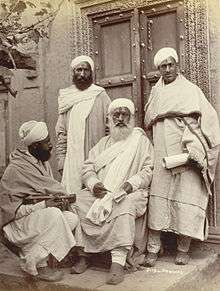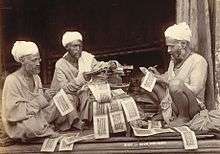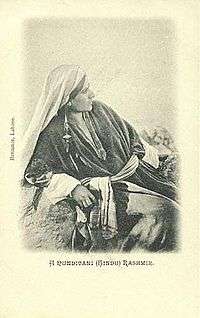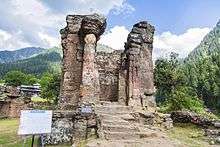Kashmiri Pandit
 | |
| Total population | |
|---|---|
| 800,000 [1] | |
| Regions with significant populations | |
|
India • Jammu and Kashmir • National Capital Region • | |
| Languages | |
| Kashmiri | |
| Religion | |
|
| |
| Related ethnic groups | |
| Dards, Indo-Aryans, Saraswat Brahmins |
The Kashmiri Pandits (also known as Kashmiri Brahmins)[2] are a Brahmin community from the Kashmir Valley,[3][4] a mountainous region in the Indian state of Jammu and Kashmir. They are the only remaining Hindu community native to the Kashmir Valley.[5]
History

Early history
The Hindu caste system of the Kashmir region was influenced by the influx of Buddhism from the time of Asoka, around the third century BCE, and a consequence of this was that the traditional lines of varna were blurred, with the exception of that for the Brahmins, who remained aloof from the changes.[6][7] Another notable feature of early Kashmiri society was the relative high regard in which women were held when compared to their position in other communities of the period.[8]
A historically contested region, Northern India was subject to attack from Turkic and Arab regimes from the eighth century onwards, but they generally ignored the mountain-circled Kashmir Valley in favour of easier pickings elsewhere. It was not until the fourteenth century that Muslim rule was finally established in the Valley and when this happened it did not occur primarily as a consequence of invasion so much as because of internal problems resulting from the weak rule and corruption endemic in the Hindu Lohara dynasty.[9][10] Mohibbul Hasan describes this collapse as
The Dãmaras (feudal chiefs) grew powerful, defied royal authority, and by their constant revolts plunged the country into confusion. Life and property were not safe, agriculture declined, and there were periods when trade came to a standstill. Socially and morally too the court and the country had sunk to the depths of degradations.[10]
The Brahmins had something to be particularly unhappy about during the reign of the last Lohara king, for Sūhadeva chose to include them in his system of onerous taxation, whereas previously they appear to have been exempted.[11]
Medieval history
Zulju, who was probably a Mongol from Turkistan,[12] wreaked devastation in 1320, when he commanded a force that conquered many regions of the Kashmir Valley. However, Zulju was probably not a Muslim.[12] The actions of Sultan Sikandar Butshikan (1389–1413), the seventh Muslim ruler in Kashmir were also significant to the area. The Sultan has been referred to as an iconoclast because of his destruction of many non-Muslim religious symbols and the manner in which he forced the population to convert or flee. Many followers of the traditional religions who did not convert to Islam instead migrated to other parts of India. The migrants included some Pandits, although it is possible that some of this community relocated for economic reasons as much as to escape the new rulers. Brahmins were at that time generally being offered grants of land in other areas by rulers seeking to utilise the traditionally high literacy and general education of the community, as well as the legitimacy conferred upon them by association. The outcome of this shift both in population and in religion was that the Kashmir Valley became a predominantly Muslim region.[13][14]
Butshikan's heir, the devout Muslim Zain-ul-Abidin (1423–74), was tolerant of Hindus to the extent of sanctioning a return to Hinduism of those who had been forcibly converted to the Muslim faith, as well as becoming involved in the restoration of temples. He respected the learning of these Pandits, to whom he gave land as well as encouraging those who had left to return. He operated a meritocracy and both Brahmins and Buddhists were among his closest advisors.[15]
Modern history


Early modern
Akbar conquered Kashmir in 1587 AD. During his mughal rule the Hindus enjoyed security of person and property and were allotted high government posts. It was he, who, pleased with their intelligence, gave them the surname Pandit.[16] The Mughals rule was followed by that of Afghans. Gradually, many Kashmiris converted to Islam, leaving smaller population of Kashmiri Pandits who still practiced the Shaivite religion. Not much was done to win back the converts to Hinduism. The majority, though still remained Hindus in Jammu and Kashmir.[17]
Modern
The Brahmin Pandits of Kashmir established themselves in the Northern area of India, first in the Rajput and Mughal courts and then in the service of the Dogra rulers of Kashmir. This cohesive community, highly literate and socially elite, were one of the first to discuss and implement social reforms.[3]

Sub categories
The society of Kashmiri Pandits is divided mainly into following sub categories.
Banmasi who had initially migrated from the valley during the rule of Muslim kings and later returned
Malmasi who stayed back in valley despite all odds. Both categories had different customs and traditions.
Later, the Pandits who started doing business were categorised as Buhirs. The difference between categories has faded due to mass migration from valley 1985 onwards.
[18]
Recent events
Exodus from Kashmir (1985–1995)
The Kashmiri Pandits had been a favoured section of the population of the valley during Dogra rule (1846–1947). 20 per cent of them left the valley as a consequence of the 1948 Muslim riots and the 1950 land reforms,[19] and by 1981 the Pandit population amounted to 5 per cent of the total.[20]
They began to leave in much greater numbers in the 1990s during the eruption of militancy, following persecution and threats by radical Islamists and militants. The events of 19 January 1990 were particularly vicious. On that day, mosques issued declarations that the Kashmiri Pandits were Kafirs and that the males had to leave Kashmir, convert to Islam or be killed. Those who chose to the first of these were told to leave their women behind. The Kashmiri Muslims were instructed to identify Pandit homes so they could be systematically targeted for conversion or killing.[21]
According to a number of authors, approximately 100,000 of the total Kashmiri Pandit population of 140,000 left the valley during the 1990s.[22] Other authors have suggested a higher figure for the exodus, ranging from the entire population of over 150,000,[23] to 190,000 of a total Pandit population of 200,000,[24] to a number as high as 800,000.[25] The nature of the planned exodus has remain controversial, with the involvement of then Governor Jagmohan in organizing a clandestine exodus been a subject of controversy.[26] Many of the refugee Kashmiri Pandits have been living in abject conditions in refugee camps of Jammu.[27] The government has reported on the terrorist threats to Pandits still living in the Kashmir region.[28][29]
In 2009 Oregon Legislative Assembly passed a resolution to recognise 14 September 2007, as Martyrs Day to acknowledge ethnic cleansing and campaigns of terror inflicted on non-Muslim minorities of Jammu and Kashmir by terrorists seeking to establish an Islamic state.[30]
In 2010, the Government of Jammu and Kashmir noted that 808 Pandit families, comprising 3,445 people, were still living in the Valley and that financial and other incentives put in place to encourage others to return there had been unsuccessful. According to a J&K government report, 219 members of the community had been killed in the region between 1989 and 2004 but none thereafter.[31] The local organisation of pandits in Kashmir, Kashmir Pandit Sangharsh Samiti after carrying out a survey in 2008 and 2009, said that 399 Kashmiri Pandits were killed by insurgents from 1990 to 2011 with 75% of them being killed during the first year of the Kashmiri insurgency.[32][33]
The exiled community had hoped to return after the situation improved. They have not done so because the situation in the Valley remains unstable and they fear a risk to their lives.[34]
As of October 2015, only 1 Kashmiri Pandit family returned to the Kashmir valley since 1990 according to the Jammu & Kashmir government despite the financial assistance being given for rehabilitation.[35] As of 2016, a total of 1,800 Kashmiri Pandit youths have returned to the valley since the announcing of Rs. 1,168-crore package in 2008 by the UPA government.[36]
PRC and the JKMIP Acts
There are zones set up with offices for relief.[37] Many Orders, Circulars and recommendations have been issued for relief of Kashmiri Pandits.[38][39][40]
The Jammu And Kashmir Migrant Immovable Property (Preservation, Protection And Restraint On Distress Sales) Act, 1997, provides that "Any person who is an unauthorised occupant or recipient of any usufruct of any immovable property of the migrant shall pay to the migrant such compensation for the period of unauthorised occupation and in such a manner as may be determined by the District Magistrate."[41]
Socio-political organisations
Following the migration of the Kashmiri Pandit community, various socio-political organisations have sprung up to represent the cause of the displaced community. The most prominent among these are the All India Kashmiri Samaj or AIKS, All India Kashmiri Pandit conference, Panun Kashmir & Kashmiri Samiti. These organisations are involved in rehabilitation of the community in the valley through peace negotiations, mobilisation of human rights groups and job creation for the Pandits.[42] Panun Kashmir has made demands for a separate homeland for the community in the southern part of Kashmir.[43]
Population distribution
In 1947, the Pandits made up about 6 percent of the Kashmir Valley's populaion.[44] By 1950, their population declined to 5 per cent as many Pandits moved to other parts of India due to the uncompensated land redistribution policy, the unsettled nature of Kashmir's accession to India and the threat of economic and social decline.[19]
Following the 1989 insurgency, a great majority of Pandits felt threatened and left the Kashmir Valley to other parts of India. A large number settled in the Jammu Division of the State and the National Capital Region of India. Some emigrated to other countries entirely.[3][44] By 2011, only an estimated 2,700-3,400 Pandits remained in the Kashmir Valley.[4]
According to Indian government, more than 60,000 families are registered as Kashmiri migrants including some Sikh and Muslim families.[45] Most families were resettled in Jammu, NCR and other neighbouring states.[46]
Religious beliefs
Kashmiri Hindus are all Saraswat Brahmins, known by their exonym of Pandit. The endonym used within the community is Bhatta.[47] Kashmiri Pandits are chiefly followers of Shiva. Their favourite goddess is Kheer Bhawani. The spring of Kheer Bhawani at the mouth of Sind Valley in Kashmir is considered one of their most important and sacred places. Their branch of Shiva worship is known as Kashmir Saivism. The primary tenet of Kashmir Shaivism is that the individual soul is one with the universal spirit, and each person has to experience and discover this for themselves.[48]
Song is an integral part of several Kashmiri Pandit religious ceremonies. This style of choral singing is called Wanvun.
Culture

Dress
Kshemendra's detailed records from the eleventh century describe many items of which the precise nature is unknown. It is clear that tunics known as kanchuka were worn long-sleeved by men and in both long- and half-sleeved versions by women. Caps were worn, as well as a type of turban referred to as a shirahshata, while footwear consisted of leather shoes and boots, worn with socks. Some items were elaborate, such as the peacock shoes – known as mayuropanah – worn by followers of fashion, and steel-soled shoes adorned with floral designs, lubricated internally with beeswax.[49]
There are many references to the wearing of jewellery by both sexes, but a significant omission from them is any record of the dejihor worn on the ear by women today as a symbol of their being married. Kaw has speculated that this item of jewellery may not have existed at the time. The texts also refer to both sexes using cosmetics, and to the women adopting elaborate hairstyles. Men, too, might adopt stylish arrangements and wear flowers in their hair, if they had the financial means to do so.[50]
Pilgrimage sites
Harmukh is traditionally revered by Kashmiri Pandits and in 2009 there was an attempt by them to revive pilgrimages to the site.[51] The Mata Khirbhawani temple shrine in Srinagar, considered one of the holiest Hindu shrines, saw the largest gathering of Kashmiri Pandits in the Kashmir valley in 2012.[52] The shrine is located in Tullamulla village, 24 km from Srinagar in Ganderbal district.[53] Some holy sites of Kashmiri Pandits include the Martand Sun Temple at Mattan, Mahakali shrine in Srinagar on the banks of vitasta, & above all the Amarnath cave shrine, the pilgrimage to which is conducted during shravan purnima.[54]

Sharada Peeth was an important learning seat of Kashmiri Hindus. It is located around 150 km from Muzaffarabad, on the banks of the river Neelum, also called Krishenganga on the Indian side of LoC. Sharda at an altitude of 1931 meters is a breath-taking green spot with numerous springs and hillsides. Shardi and Nardi are two peaks overlooking the valley, named after the legendary princesses Sharda and Narda. The old script of Kashmiri language Sharada has derived its name from this place. The ruins of an ancient buddhist monastery and fort are located here.[55]
Festivals
The religious festivals of the Brahmins of Kashmir have mostly Vedic roots, with significant Buddhist influence and some Zoroastrian influence as well. The Kashmiri Pandits share many of their festivals with other Hindu Brahmin communities. Shivratri (or Herath as it is known in the Kashmiri language) is one of the major festivals of Kashmiri Pandits. Navreh or the Kashmiri lunar new year is also an important Pandit festival.[56]
See also
References
- ↑ "Kashmir's Pandits". Dawn (newspaper). 9 July 2016. Retrieved 20 July 2016.
- ↑ Duchinsky, Haley (26 September 2013). "Survival is now our Politics: Kashmiri Hindu community identity and the Politics of Homeland". www.academia.edu.
- 1 2 3 Lyon, Peter (2008). Conflict between India & Pakistan: An Encyclopedia. p. 99. ISBN 9781576077122.
- 1 2 Essa, Assad (2 August 2011). "Kashmiri Pandits: Why we never fled Kashmir". aljazeera.com. Retrieved 15 August 2012.
- ↑ Kashmir and It's People: Studies in the Evolution of Kashmiri Society. p. 183.
- ↑ Bamzai, Prithivi Nath Kaul (1994). Culture and political history of Kashmir, Volume 1. M.D. Publications Pvt. Ltd. pp. 191–192. ISBN 978-81-85880-31-0.
- ↑ Kaw, M. K. (2004). Kashmir and its people: studies in the evolution of Kashmiri society. Volume 4 of KECSS research series: Culture and heritage of Kashmir. APH Publishing. p. 90. ISBN 978-81-7648-537-1.
- ↑ Kaw, M. K. (2004). Kashmir and its people: studies in the evolution of Kashmiri society. APH Publishing. p. 91. ISBN 978-81-7648-537-1. Retrieved 2 August 2011.
- ↑ Stein, Mark Aurel (1989) [1900]. Kalhana's Rajatarangini: a chronicle of the kings of Kasmir, Volume 1 (Reprinted ed.). Motilal Banarsidass. pp. 106–108. ISBN 978-81-208-0369-5. Retrieved 18 July 2011.
- 1 2 Hasan, Mohibbul (2005) [1959]. Kashmir Under the Sultans (Reprinted ed.). Delhi: Aakar Books. pp. 29–32. ISBN 978-81-87879-49-7. Retrieved 8 July 2011.
- ↑ Hasan, Mohibbul (2005) [1959]. Kashmir Under the Sultans (Reprinted ed.). Delhi: Aakar Books. p. 34. ISBN 978-81-87879-49-7. Retrieved 8 July 2011.
- 1 2 Hasan, Mohibbul (2005) [1959]. Kashmir Under the Sultans (Reprinted ed.). Delhi: Aakar Books. p. 35. ISBN 978-81-87879-49-7. Retrieved 8 July 2011.
- ↑ Davidson, Ronald M. (2004) [2002]. Indian Esoteric Buddhism: A Social History of the Tantric Movement (Reprinted (for SE Asia sale only) ed.). New York: Columbia University Press. pp. 70–71. ISBN 978-81-208-1991-7. Retrieved 8 July 2011.
- ↑ Hasan, Mohibbul (2005) [1959]. Kashmir Under the Sultans (Reprinted ed.). Delhi: Aakar Books. pp. 28–95. ISBN 978-81-87879-49-7. Retrieved 8 July 2011.
- ↑ Hasan, Mohibbul (2005) [1959]. Kashmir Under the Sultans (Reprinted ed.). Delhi: Aakar Books. pp. 87, 91–93. ISBN 978-81-87879-49-7. Retrieved 8 July 2011.
- ↑ Bakshi, S.R. (1997). Kashmir:History & People. Sarup & Sons. p. 103. ISBN 8185431965. Retrieved 8 July 2012.
- ↑ Kaw, M.K. (2004). Kashmir & Its People: Studies in the evolution of Kashmiri society. APH Publishing House. p. 183. ISBN 8176485373.
- ↑ Mohan, Lalit (2 July 2007). "Patiala doctor pens book on Kashmiri Pandits". Tribune India. Retrieved 21 April 2015.
- 1 2 Zutshi, Languages of Belonging 2004, p. 318 Quote: "Since a majority of the landlords were Hindu, the (land) reforms (of 1950) led to a mass exodus of Hindus from the state. ... The unsettled nature of Kashmir's accession to India, coupled with the threat of economic and social decline in the face of the land reforms, led to increasing insecurity among the Hindus in Jammu, and among Kashmiri Pandits, 20 per cent of whom had emigrated from the Valley by 1950."
- ↑ K Pandita, Rahul (2013). Our Moon has Blood Clots: The Exodus of the Kashmiri Pandits. Vintage Books / Random House. p. 255. ISBN 9788184000870.
- ↑ Tej Kumar Tikoo, Kashmiri Pandits offered three choices by Radical Islamists, India Defence Review, 19 January 2015.
- ↑ Bose 1997, p. 71, Rai 2004, p. 286,Metcalf & Metcalf 2006, p. 274
- ↑ Malik 2005, p. 318
- ↑ Madan 2008, p. 25
- ↑ Noorani, A.G. (9 July 2016). "Kashmir's Pandits". Dawn. Retrieved 20 July 2016 – via Google Books.
- ↑ "25 years after exodus of Kashmiri Pandits from the Valley, questions over return remain". Retrieved 2014-01-27.
- ↑ "BBC World Service | World Agenda - Give me land". Bbc.co.uk. Retrieved 2013-03-28.
- ↑ "23 years on, Kashmiri Pandits remain refugees in their own nation - Rediff.com India News". Rediff.com. 2012-01-19. Retrieved 2013-03-28.
- ↑ "India". Bureau of Democracy, Human Rights, and Labor, US Department of State. 6 March 2007. Retrieved 8 July 2011.
- ↑ Senate Joint Resolution 23, 75th OREGON LEGISLATIVE ASSEMBLY—2009 Regular Session
- ↑ "Front Page : "219 Kashmiri Pandits killed by militants since 1989"". The Hindu. 2010-03-24. Retrieved 2013-03-28.
- ↑ Azad Essa. "Kashmiri Pandits: Why we never fled Kashmir – Kashmir: The forgotten conflict". Al Jazeera English. Retrieved 2012-08-03.
- ↑ GreaterKashmir.com (Greater Service) (20 June 2011). "399 Pandits killed since 1990 KPSS Lastupdate:- Mon, 20 Jun 2011 18:30:00 GMT". Greaterkashmir.com. Retrieved 2012-05-24.
- ↑ Masih, Archana (29 April 2011). "The tragedy of Kashmiri Pandits (Part IV)". Rediff.com. Retrieved 7 July 2011.
- ↑ "Only 1 Pandit family returned to Valley in 25 years: J&K govt to SC".
- ↑ "When will we finally return home, ask displaced Kashmiri Pandits".
- ↑ "Untitled Page". Retrieved 20 June 2016.
- ↑ "Untitled Page". Retrieved 20 June 2016.
- ↑ "Recommendations of Koul Committee" (PDF). Retrieved 21 May 2011.
- ↑ http://jkmigrantrelief.nic.in/pdf/recommendations_of_inter_ministerial_team.pdf
- ↑ "The Jammu Jammu And Kashmir Gazette" (PDF). Retrieved 21 May 2011.
- ↑ "Kashmiri pandit team to visit valley to negotiate for peace". The Indian Express. 16 May 2000. Retrieved 26 September 2013.
- ↑ "Pandits to float Political Party". The Hindustan Times. 2 January 2007. Retrieved 26 September 2013.
- 1 2 Snedden, Christopher (2015), Understanding Kashmir and Kashmiris, Oxford University Press, ISBN 978-1-84904-342-7
- ↑ http://pib.nic.in/newsite/PrintRelease.aspx?relid=131618
- ↑ http://pib.nic.in/newsite/PrintRelease.aspx?relid=106628
- ↑ Barbara Anne Brower, Barbara Rose Johnston. Disappearing Peoples? Indigenous groups and ethnic minorities in South & Central Asia. Left Coast Press, Indiana University. p. 138. ISBN 9781598741209. Retrieved 29 Dec 2012.
- ↑ Kaw, M.K. (2002). Kashmir Saivism: Under Siege. A.P.H. Publishing Corporation, Darya Ganj, New Delhi. p. 16. ISBN 8176483605.
- ↑ Kaw, pp. 94–95.
- ↑ Kaw, pp. 95–97.
- ↑ "Gangbal yatra to commence after 100 yrs in Kashmir". Zeenews. 31 May 2009. Retrieved 8 July 2011.
- ↑ indianexpress.com, Srinagar (8 Jun 2009). "Valley divide impacts Kashmiri, pandit youth switch to devnagari".
- ↑ Biharprabha, News (29 May 2012). "Hindu Muslim unity depicted at Mata Khirbhawani temple in Kashmir".
- ↑ Dhar, Triloki Nath. Kashmiri Pandit Community: A Profile. Mittal Publications, Darya Ganj, New Delhi. p. 73. ISBN 8183241778.
"Above all, we have Swami Amarnath, serene in his cave, up in his mountains, the Pilgrimage to which is an annual feature of Shravana Purnima
- ↑ Deccan Chronicle, Yusuf Jameel (13 April 2016). "Kashmiri pandits pitch for reopening of 'seat of learning' in PoK for them". Retrieved 17 April 2016.
- ↑ Ling, Huping. Emerging Voices, experiences of underrepresented Asian Americans. Rutgers University Press. p. 135. Retrieved 17 August 2012.
Bibliography
- Bose, Sumantra (1997), The challenge in Kashmir: democracy, self-determination, and a just peace, New Delhi: Sage Publications, in association with The Book Review Literary Trust, ISBN 978-0-8039-9350-1
- Madan, T. N. (2008), "Kashmir, Kashmiris, Kashmiriyat: An Introductory Essay", in Rao, Aparna, The Valley of Kashmir: The Making and Unmaking of a Composite Culture?, Delhi: Manohar. Pp. xviii, 758, pp. 1–36, ISBN 978-81-7304-751-0
- Malik, Iffat (2005), Kashmir: Ethnic Conflict, International Dispute, Karachi and Oxford: Oxford University Press. Pp. xxvi, 392, ISBN 0-19-579622-5
- Metcalf, Barbara; Metcalf, Thomas R. (2006), A Concise History of Modern India (Cambridge Concise Histories), Cambridge and New York: Cambridge University Press. Pp. xxxiii, 372, ISBN 0-521-68225-8.
- Rai, Mridu (2004), Hindu Rulers, Muslim Subjects: Islam, Rights, and the History of Kashmir, Princeton University Press/Permanent Black. Pp. xii, 335., ISBN 81-7824-202-8
- Zutshi, Chitralekha (2004), Languages of Belonging: Islam, Regional Identity, and the Making of Kashmir, C. Hurst & Co. Publishers, ISBN 978-1-85065-700-2
Further reading
- Bose, Sumantra (2005). Kashmir: roots of conflict, paths to peace. Harvard University Press. ISBN 978-0-674-01817-4.
- Zutshi, Chitraleka (2008). "Shrines, Political Authority, and Religious Identities in Late-Nineteenth and Early-Twentieth-century Kashmir". In Rao, Aparna. The Valley of Kashmir: The Making and Unmaking of a Composite Culture?. Delhi: Manohar. pp. 235–258. ISBN 978-81-7304-751-0.
External links
- Shehjar News Magazine
- Kashmiri Overseas Association, Inc. (KOA), USA
- Kashmir Hindu Foundation (KHF)
- Kashmir-information.com
- Indo-American Kashmir Forum – a U.S. based political advocacy group for the Kashmiri Pandits
- Panun Kashmir: A Homeland for Kashmiri Pandits
- Video Documentary 'Lost Paradise' on RefugeeCamps of Kashmiri Hindus by Deepak Ganju
- 'God of Small Things,' Travelogue in The Indian Express, 5 March 2006, by Arjun Razdan
- Kashmiri Pandit association of Europe